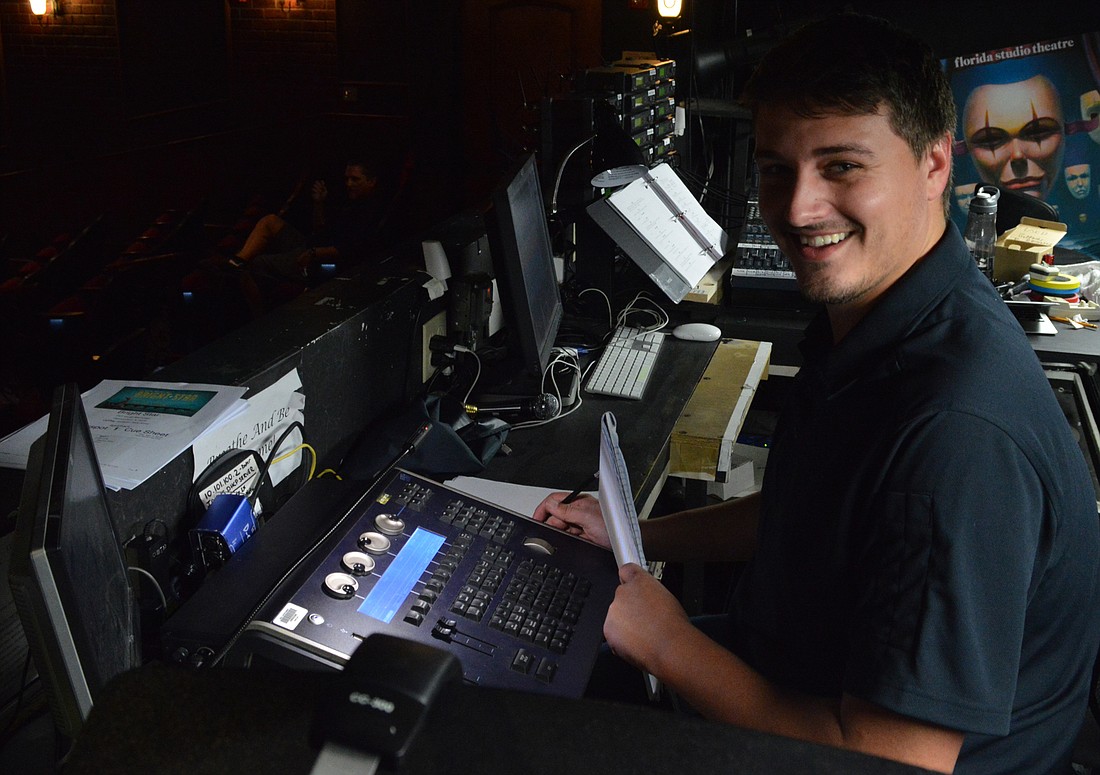- April 19, 2024
-
-
Loading

Loading

“The play’s the thing.” But here’s the thing: If the audience can’t see the play, the show doesn’t go on. But not if lighting designer Nick Jones can help it. At the most basic level, it’s his job to make the action on stage visible. At a deeper level, he illuminates the play’s emotional subtext and keeps its action grounded in place and time. Jones has been keeping the lights on for a host of theater companies since he graduated from Booker VPA. His credits at Florida Studio Theatre include “Hand to God,” “Cherry Docs” and most recently “Bright Star.” The unconventional musical explores love, family, peace and music in mid-20th century America. It’s not a typical production, but for Jones, there’s no such thing. His lighting choices are never the same twice. And that’s why he loves his job.
That’s one of the perks of being a Sarasota native. Growing up here, I was lucky to be exposed to all kinds of creative fields from a very young age.
For me, it started in middle school. My first experience was at Sarasota School of Arts and Sciences. On my first day, I walked into a dark, drab, black box performance space with a total of eight lights. By the end of my first school year, I was able to bring up those eight lights and transform the environment into something magical. I loved the feeling that, with a push of a button, I could change an entire environment, both physically and metaphysically. I was hooked from then on and continued my studies with Ken Wiegers at Booker VPA in high school.
I think it was probably 2010, when I was still in high school. I was able to work for the Banyan Theater Company. I became very close with Michael Pasquini, their lighting director. I learned that he was also a Booker High graduate. We bonded over that, and he took me under his wing. I learned so much with him — and I’ve continued to learn, especially at FST. Like they say, “You’re only as good as your last show.” Well, I’ve learned something new with every show. Creative collaboration makes you better. I’ve honed my craft here, and I’m so grateful for the opportunity.
After “Bright Star,” I think it’ll be 11 shows.
First, the band is on stage. You want to create a mood; they want to see their instruments. I have to find that sweet spot so they can, and the lighting doesn’t interfere with storytelling. There’s also the fact that “Bright Star” is set in two different time frames. Kate Alexander is directing, and she didn’t want to put up a sign saying “1923” or “1945.” Instead, I had to visually communicate that with subtle lighting cues. So the scenes from Alice’s childhood have more texture, but we don’t hit you over the head with it. I also use lighting to communicate the characters’ state of mind.
Well, a character like Alice might dive down into their internal thoughts. I’ll often use top and sidelights to indicate their separation from the scene.
“Bright Star” has upwards of 380. A typical theatergoer might recognize about 100 of them.
Something like that. I start with the script and break down the lighting placement from scene to scene. After that, I’ll hand off the plan to the electrical teams. Tracking tools for spotlights are a totally separate problem. Paperwork is 90% of an LD’s job. Nothing’s left to chance!
Creatively, I’d have to say “Hand To God,” which Jason Cannon directed in Bowne’s Lab. It’s such an interesting space. It’s a tiny, space, with maybe 40 lights and a console from the 1990s. Despite these physical challenges, we painted some gorgeous pictures with light.
I think he’s right. We’d all love like to have a few million dollars to play with. The truth is, having a limited staff and budget can force you to think about things in a completely different way.
Who wouldn’t love to change their environment every day? I go from space to space and room to room in a creative collaboration with other artists from all walks of life. We might have a few little family arguments, but we share a broad creative vision. Working with other artists and creating something beautiful never gets old.